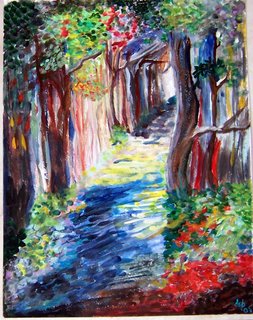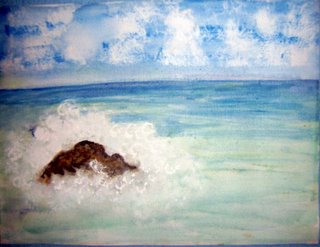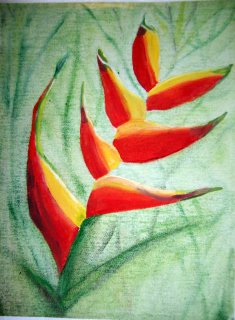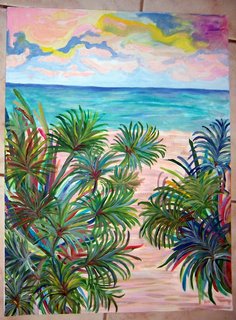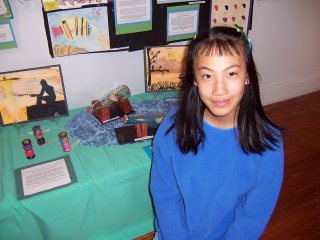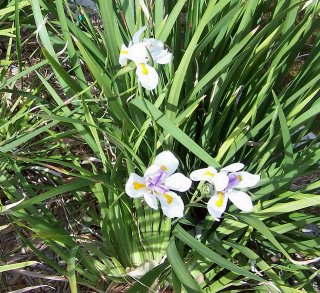A Yankee in Bermuda
Monday, February 27, 2006
A Good Place for Painting
With more unscheduled time available to me in Bermuda than I've ever had before, I've been doing some painting. My friend Peter Beves gave me some wonderful canvas for Christmas, so I've experimented with that, doing both watercolors and acrylics. Here's the result so far.
Wednesday, February 22, 2006
Giant Toads
The other night when we came home from an outing, one of Bermuda's giant toads was making its way across the driveway. They are as big as a dessert plate and can be 6 inches long...not your average garden-variety toad. The giant toad (Bufo marinus) was introduced to Bermuda in 1875 as a way to help combat cockroaches. And, indeed, the toads eat just about everything from insects to pet food. The male toads will also try to mate with anything that looks remotely like another large toad...even a shoe. In Belize, these amphibians are called "Spring Chicken," although I don't think I want to know why.
Our yellow lab, Molly, had an interesting encounter with one these critters when she discovered one in the garden. As soon as I said, "Molly, no!" she picked up her quarry in her mouth, no doubt thinking that I would take the forbidden "prize" away from her. Within seconds, she spit out the toad and her mouth began to foam. While Abby and I watched in astonishment, Molly grew three foam beards of saliva in quick succession: a new one grew as the previous one fell off. It turns out that Bufo marinus has enlarged poison glands on each shoulder for protection against predators and when the poison made contact with Molly mouth tissue, HER defenses kicked in to rid her body of the poison. It was like watching "Wild Kingdom": "Here in the savannah, the creatures who live here, from the giant toad to the yellow lab, have developed specialized protections to ensure their survival."
Here is a photo of Abby gingerly touching a giant toad on its side. Abby likes reptiles and to us, it looked like simply a much larger version of the toads we often found in our garden in Gorham, Maine. We didn't find out about the poisonous shoulder glands until the "Wild Kingdom" incident with Molly.
Saturday, February 11, 2006
All Bottled Up
Here's Abby looking very pleased to have her ship-in-a-bottle on display at the City Hall in Hamilton. Hundreds of pieces of artwork have been completed by kids from all the island's schools. It's really amazing to see how creative and skilled many of the kids are.
Plant in the Hat
Dr. Seuss MUST have come to Bermuda on a visit in his early years and seen this plant. It seems to me that this plant was the inspiration for countless illustrations.
Wednesday, February 08, 2006
Bermuda Shorts
Warmer weather has returned once again and with it, Bermuda shorts! Eric is shown here in the typical men's business attire in Bermuda, complete with his Blackberry: that electronic umbilical cord to the office.
Wednesday, February 01, 2006
"Just the Facts, Ma'am."
For those of you who were wondering (or not), the island now known as Bermuda formed 100 million years ago as a volcanic mountain. Layers of ancient lava can be found under the surface strata of limestone. Pretty exciting stuff, huh?
Bermuda was discovered by Spanish explorer Juan de Bermudez (what are the chances??!) who was shipwrecked on a nearby reef in 1503. In the following years, explorers from many nationalities found Bermuda to be a convenient stopping point in their travels. One explorer left a few hogs to multiple on the island as a future food source and multiple they did. Hence, early currency was named the "Hog Penny" after these abundant critters.
Now for the REALLY exciting part. Bermuda consists of 20.75 square miles and had a resident population of an estimated 68,500 residents at year-end 2005. Consequently, Bermuda has the third highest population density of any country in the world. Yesterday's (Jan. 31, 2006) Royal Gazette reported that by 2030, the Island's population could balloon to 74,000 residents or a population density of 3,572 persons per square mile. Approximately 63 percent of the population is black, 33 percent is white, and 4 percent is Asian or "other."
The Bermuda Bird is the cahow or Bermuda Petrel, a bird that was thought, until recently, to be extinct. The cahow had once lived on the island in huge numbers, but it had made a significant evolutionary mistake: it dug nests or burrows in the sand in which to lay eggs. Once the pigs, dogs, and humans arrived, this proved to be a tactical error on the part of the cahow. There was great excitement (well, in some circles) when the first breeding sites of the nearly extinct remaining cahows were found on some of the small tufts of land (islets) in Castle Harbour in 1951.
The Bermuda Flower, a member of the iris family, is called the Bermudiana. My husband, Eric, likes to say, "How lucky is that?!" The Bermuda Tree (Juniperus bermudiana L) is the Bermuda cedar, one of only 17 land plants that are endemic to the island. The once ubiquitous cedar, however, was nearly wiped out by a tree disease (scale insects) that struck after 1944. Approximately 90 percent of the trees on the island were killed. The trees are slowly making a modest comeback.
The Bermuda Vegetable is the onion and locals like to call themselves "Onions," similar, perhaps, to the locals of Key West who call themselves "Conchs."
So there you have it (whether you wanted it or not...): a few facts about Bermuda.
Real estate is very difficult for non-Bermudians to acquire, especially with new regulations that were put in place in February 2005. With these regulations, non-Bermudians are allowed to purchase only those homes with an annual rental value above $153,000. In addition, non-Bermudians can purchase these homes only from non-Bermudians. The average price of a 2-3 bedroom house (the non-Bermudian rate) was $2.6 million in 2005.
The cost of living in Bermuda is said to be 380% higher than in the US, 280% more than Canada, and 220% more than the UK. Here's a sample of grocery prices, as follows:
Campbells Creamy Chicken Soup $ 1.43
Spring mix salad greens $ 5.29
Baby spinach $ 5.99
Plum tomatoes (0.88 lb) $ 2.37
Westoy Soy Milk $ 3.63
Rubbermaid 1 qt container $ 6.25
Anchor salted butter $ 2.39
Tropicana OJ with calcium $ 5.13
Breyers ice cream $ 8.75
Stilton cheese $ 6.20
Perdue ground turkey $ 3.99
Fancy Feast (per can) $ .67
Applegate turkey hot dogs $ 6.83
Thomas plain bagels $ 5.69
Frozen peas $ 4.53
Apples (each) $ 1.10
Canada Dry tonic water $ 2.65
Three Diamond crab meat (can) $ 3.55
Murphy's Irish Red beer $ 9.90
Red seedless grapes (per pound)$ 4.99
Button mushrooms $ 3.25
Bananas (per pound) $ 1.49
Well, you get the idea...
To have the internet and a phone in Bermuda costs us $200 each month. The cost of cable or satellite TV is twice as much as in the US. Gasoline is $1.50 per liter (one gallon contains 3.79 liters, so that's approx. $5.69 per gallon) and gas station attendents expect a tip (as do the grocery baggers!).
Our little cottage (living room, 2 bedrooms, 1 bathroom, dining room, kitchen, attached laundry) costs $3,700/month, which is about average. We are fortunate in that we are on the "high ground" and have a lovely view of both the Atlantic Ocean and Harrington Sound. We are also allowed to have pets, so that's built in as part of the rental cost, I would think.
More later...
